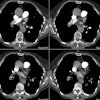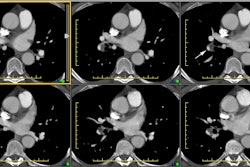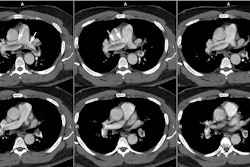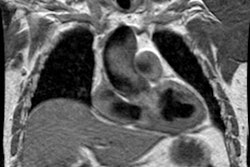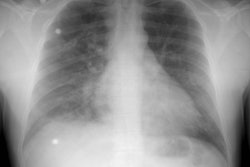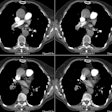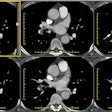Penetrating Aortic Ulcer:
View cases of penetrating aortic ulcer
Clinical:
Penetrating aortic ulcer (PAU) occurs due to ulceration of an atherosclerotic plaque that penetrates into the internal elastic lamina, resulting in hematoma formation within the media of the aortic wall. PAU distinguishes itself from common ulcerated atherosclerotic plaque by burrowing beyond the intima and penetrating into the media and its internal elastic lamina, which separates the two layers, producing wall expansion and smooth bulging at the involved level [8]. Most affected patients are elderly with a history of hypertension and often present with acute chest or back pain- similar to acute dissection [6]. The ulceration most commonly occurs in the middle or distal third of the descending thoracic aorta [4]. Only about 11% of cases involve the ascending aorta [4]. An associated intramural hematoma occurs in over 80% of cases [1,5].
The nature history of a penetrating ulcer is variable [4]. PAUs
of 10 mm depth and 20 mm diameter are associated with a higher
risk of progression [7]. About one-third of lesions progress over
time [2,3], even as the associated hematoma becomes smaller [1].
Changes associated with progression include: 1) an increase in the
size of the ulcer and aortic diameter; 2) incorporation of the
ulcer into the aortic wall contour with an increase in aortic
diameter; and 3) an increase in aortic diameter without change in
the ulcer [2]. A saccular pseudoaneurysm can occur in up to 25-30%
of cases [1]. Rupture of the aortic wall occurs in about 8% of
cases [1]- the risk of rupture increases with increasing size of
the aorta at the level of the ulceration [5]. Dissection can also
occur as a complication [5].
Stable patients are treated to provide pain relief and hypertension control. Follow-up imaging in 6 to 12 weeks should be performed, although other authors recommend imaging within 30 days if conservative management is performed [6]. Indications for surgical treatment include persistent or recurrent pain, expanding intramural hematoma, distal embolization, rapid enlargement of the aortic diameter, or hemodynamic instability [1,3]. Endovascular stent graft placement has also been used successfully in the treatment of penetrating ulcer [3,5].
X-ray:
Computed tomography: A penetrating ulcer appears as a focal contrast collection projecting beyond the aortic lumen [1]. An associated intramural hematoma is very common and produces a crescent-shaped area of mural thickening which frequently has increased attenuation reflecting acute hemorrhage.
Angiography: An ulcer may not be identified if the ulcer is not profiled on the image projections obtained [1].
REFERENCES:
(1) AJR 1999; Levy JR, et al. Imaging of penetrating
atherosclerotic ulcers of the aorta. 173: 151-154
(2) Radiology 2001; Quint LE, et al. Ulcerlike lesions of the aorta: Imaging features and natural history. 218: 719-23
(3) AJR 2001; Sailer J, et al. Endovascular treatment of aortic type B dissection and penetrating ulcer using commercially available stent-grafts. 1365-1369
(4) Radiol Clin N Am 2005; Chiles C, Carr JJ. Vascular diseases of the thorax: evaluation with multidetector CT. 43: 543-569
(5) Radiographics 2008; Bean MJ, et al. Thoracic aortic stent-grafts: utility of multidetector CT for pre- and postprocedure evaluation. 28: 1835-1851
(6) AJR 2009; Litmanovich D, et al. CT and MRI in diseases of the
aorta. 193: 928-940
(7) Radiographics 2021; Ko JP, et al. Chest CT angiography for
acute aortic pathologic conditions: pearls and pitfalls. 41:
399-424
(8) Radiographics 2021; Murillo H, et al. Aortic dissection and other acute aortic syndromes: diagnostic imaging findings from acute to chronic longitudinal progression. 41: 425-446
